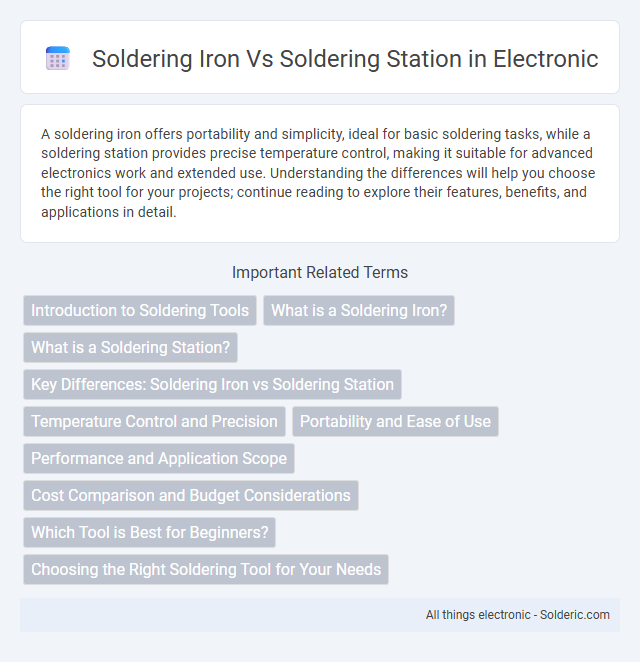A soldering iron offers portability and simplicity, ideal for basic soldering tasks, while a soldering station provides precise temperature control, making it suitable for advanced electronics work and extended use. Understanding the differences will help you choose the right tool for your projects; continue reading to explore their features, benefits, and applications in detail.
Comparison Table
| Feature | Soldering Iron | Soldering Station |
|---|---|---|
| Temperature Control | Limited or none | Precise and adjustable |
| Power | Typically 30-60W | Typically 40-80W |
| Cost | Lower price, affordable for beginners | Higher price, professional use |
| Portability | Highly portable, lightweight | Less portable, includes base unit |
| Accuracy | Less precise temperature stability | Stable temperature for sensitive work |
| Functionality | Basic soldering tasks | Advanced soldering, multi-functional |
| Ideal Use | Hobbyists, quick repairs | Professionals, electronics assembly |
Introduction to Soldering Tools
Soldering irons are handheld tools designed for quick, precise soldering tasks, ideal for beginners or simple electronics repairs. Soldering stations offer advanced temperature control, stability, and interchangeable tips, making them suitable for professional or complex projects requiring consistent heat. Choosing between your soldering iron and soldering station depends on the level of precision and temperature management needed for your soldering tasks.
What is a Soldering Iron?
A soldering iron is a handheld tool designed to melt solder, enabling the joining of metal components in electronic projects and repairs. It typically features a heated metal tip that reaches temperatures sufficient to liquefy solder wire, allowing precise application on circuit boards or wires. Your choice of a soldering iron depends on the wattage, tip type, and temperature control, influencing accuracy and ease of use.
What is a Soldering Station?
A soldering station is an advanced electronic tool designed for precision soldering tasks, featuring a separate temperature-controlled soldering iron connected to a main control unit. It allows precise temperature adjustment, enhancing soldering quality and preventing damage to sensitive components compared to basic soldering irons. This setup provides better heat stability, making it ideal for electronics repair, circuit board assembly, and professional-grade soldering applications.
Key Differences: Soldering Iron vs Soldering Station
A soldering iron is a handheld tool primarily designed for simple, low-precision soldering tasks, featuring a fixed power output and basic temperature control. A soldering station offers advanced temperature regulation, interchangeable tips, and often includes a digital display, making it ideal for precise electronic work and professional use. Your choice depends on the complexity of the project and the level of control required, with soldering stations providing superior stability and versatility over standard soldering irons.
Temperature Control and Precision
Soldering stations provide superior temperature control and precision compared to soldering irons, allowing you to set and maintain exact temperatures for delicate electronic components. Unlike standard soldering irons with limited or no adjustable settings, soldering stations use digital controllers and sensors to ensure consistent heat delivery, minimizing the risk of overheating or damaging sensitive parts. Precision temperature management enhances the quality of solder joints and improves overall reliability in your electronics projects.
Portability and Ease of Use
A soldering iron offers superior portability due to its compact design and lightweight nature, making it ideal for on-the-go repairs and quick tasks. Soldering stations provide enhanced ease of use with adjustable temperature controls and stable power supply, ensuring precise and consistent soldering results. Your choice depends on whether you prioritize mobility or advanced functionality for detailed projects.
Performance and Application Scope
Soldering stations typically offer higher performance with precise temperature control, making them ideal for delicate electronics and professional use. Soldering irons are more portable and straightforward, suitable for basic repairs and hobbyist projects. The broader application scope of soldering stations includes advanced tasks like PCB assembly, while soldering irons fit simpler soldering needs.
Cost Comparison and Budget Considerations
Soldering irons typically cost less upfront, making them a budget-friendly choice for hobbyists and occasional users, while soldering stations come with advanced temperature controls and additional features that increase their price but enhance precision and durability. Investing in a soldering station may offer better long-term value due to its adjustable settings and replaceable tips, reducing maintenance expenses over time. Your decision should weigh the initial cost against the frequency and complexity of your soldering projects to find the best fit for your budget.
Which Tool is Best for Beginners?
Soldering stations offer better temperature control and consistent heating, making them ideal for beginners who need precision and safety during soldering tasks. Soldering irons are simpler, more portable, and budget-friendly, suitable for beginners starting with basic electronics or occasional repairs. For beginners aiming to develop skills with reliable results, a soldering station provides a more user-friendly and effective learning experience.
Choosing the Right Soldering Tool for Your Needs
Selecting the appropriate soldering tool depends on your specific requirements, such as the complexity of your projects and frequency of use. A soldering iron offers portability and simplicity, making it ideal for basic repairs and occasional tasks, while a soldering station provides precise temperature control and enhanced stability suited for professional or extensive electronics work. Assessing your soldering demands ensures that you invest in a tool that maximizes efficiency and quality in your work.
soldering iron vs soldering station Infographic

 solderic.com
solderic.com